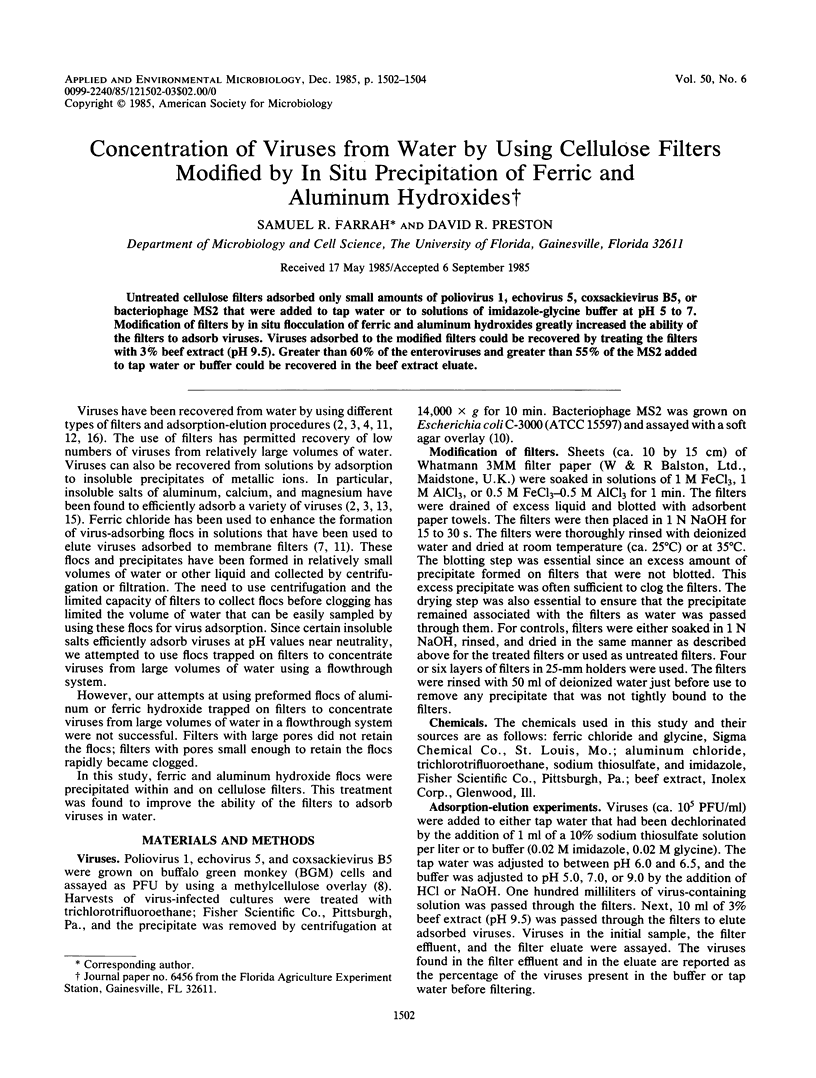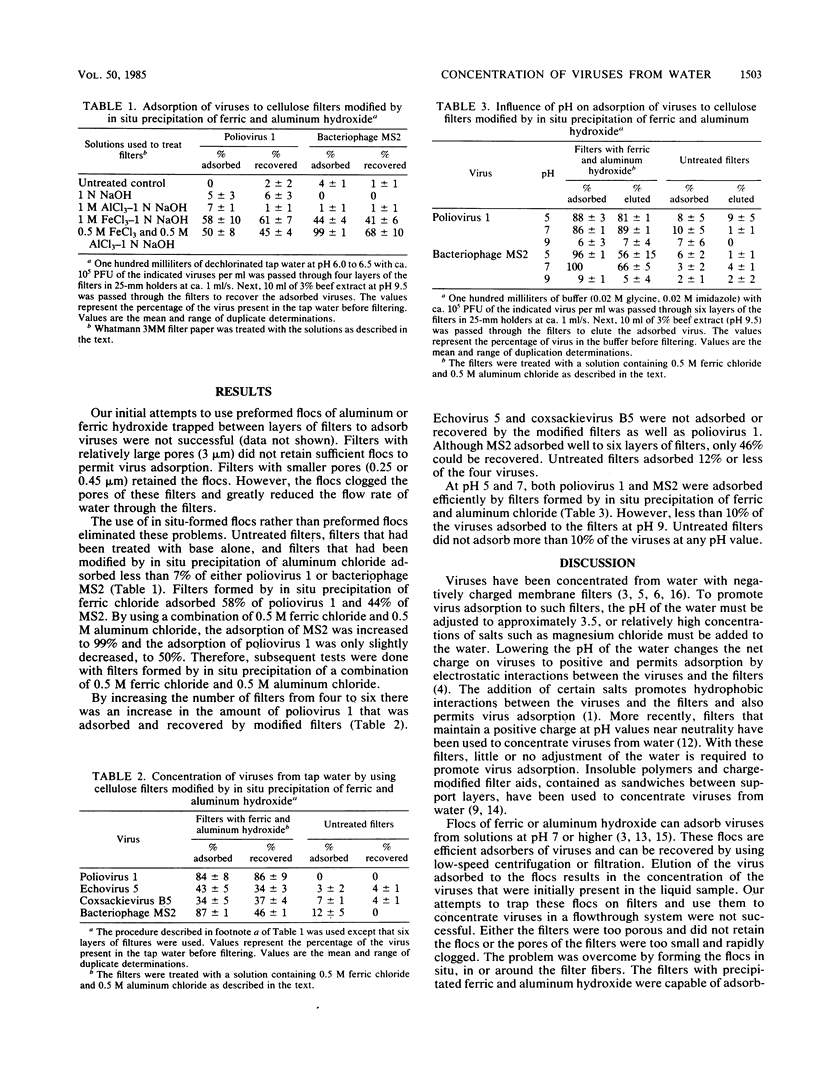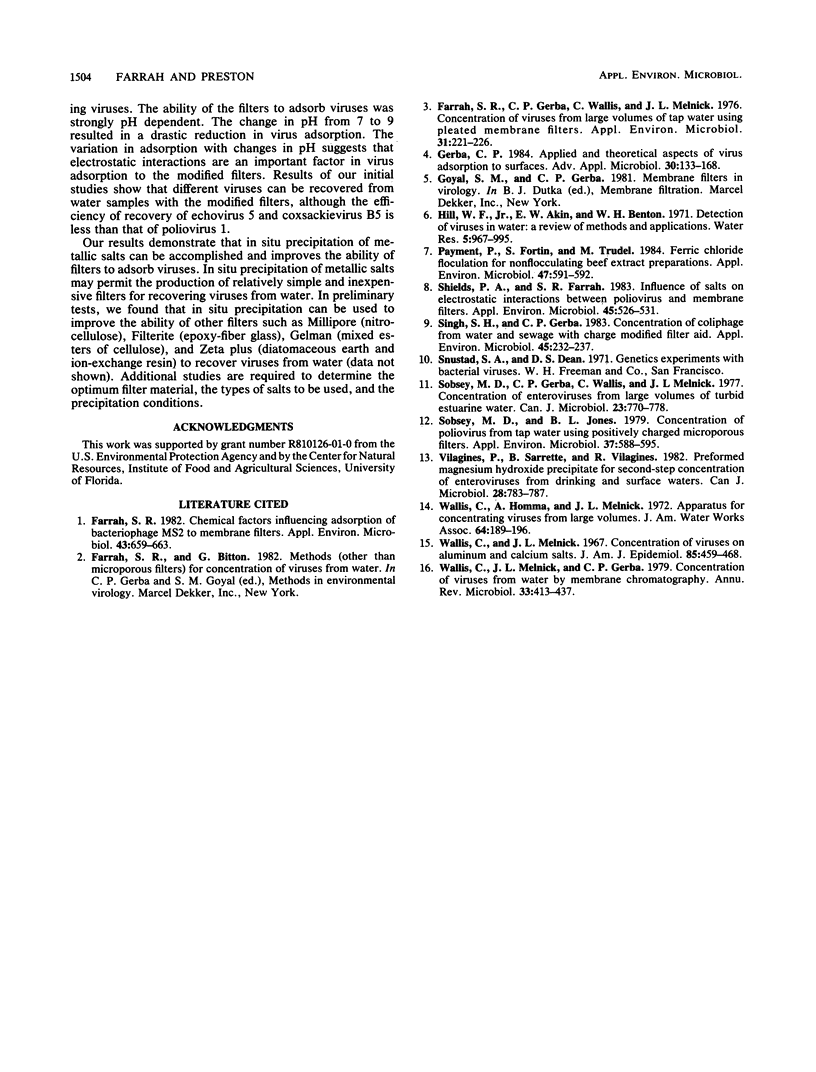Abstract
Untreated cellulose filters adsorbed only small amounts of poliovirus 1, echovirus 5, coxsackievirus B5, or bacteriophage MS2 that were added to tap water or to solutions of imidazole-glycine buffer at pH 5 to 7. Modification of filters by in situ flocculation of ferric and aluminum hydroxides greatly increased the ability of the filters to adsorb viruses. Viruses adsorbed to the modified filters could be recovered by treating the filters with 3% beef extract (pH 9.5). Greater than 60% of the enteroviruses and greater than 55% of the MS2 added to tap water or buffer could be recovered in the beef extract eluate.
Full text
PDF


Selected References
These references are in PubMed. This may not be the complete list of references from this article.
- Farrah S. R. Chemical factors influencing adsorption of bacteriophage MS2 to membrane filters. Appl Environ Microbiol. 1982 Mar;43(3):659–663. doi: 10.1128/aem.43.3.659-663.1982. [DOI] [PMC free article] [PubMed] [Google Scholar]
- Farrah S. R., Gerba C. P., Wallis C., Melnick J. L. Concentration of viruses from large volumes of tap water using pleated membrane filters. Appl Environ Microbiol. 1976 Feb;31(2):221–226. doi: 10.1128/aem.31.2.221-226.1976. [DOI] [PMC free article] [PubMed] [Google Scholar]
- Gerba C. P. Applied and theoretical aspects of virus adsorption to surfaces. Adv Appl Microbiol. 1984;30:133–168. doi: 10.1016/s0065-2164(08)70054-6. [DOI] [PubMed] [Google Scholar]
- Payment P., Fortin S., Trudel M. Ferric chloride flocculation for nonflocculating beef extract preparations. Appl Environ Microbiol. 1984 Mar;47(3):591–592. doi: 10.1128/aem.47.3.591-592.1984. [DOI] [PMC free article] [PubMed] [Google Scholar]
- Shields P. A., Farrah S. R. Influence of salts on electrostatic interactions between poliovirus and membrane filters. Appl Environ Microbiol. 1983 Feb;45(2):526–531. doi: 10.1128/aem.45.2.526-531.1983. [DOI] [PMC free article] [PubMed] [Google Scholar]
- Singh S. N., Gerba C. P. Concentration of coliphage from water and sewage with charge-modified filter aid. Appl Environ Microbiol. 1983 Jan;45(1):232–237. doi: 10.1128/aem.45.1.232-237.1983. [DOI] [PMC free article] [PubMed] [Google Scholar]
- Sobsey M. D., Gerba C. P., Wallis C., Melnick J. L. Concentration of enteroviruses from large volumes of turbid estuary water. Can J Microbiol. 1977 Jun;23(6):770–778. doi: 10.1139/m77-114. [DOI] [PubMed] [Google Scholar]
- Sobsey M. D., Jones B. L. Concentration of poliovirus from tap water using positively charged microporous filters. Appl Environ Microbiol. 1979 Mar;37(3):588–595. doi: 10.1128/aem.37.3.588-595.1979. [DOI] [PMC free article] [PubMed] [Google Scholar]
- Vilagines P., Sarrette B., Vilagines R. Preformed magnesium hydroxide precipitate for second-step concentration of enteroviruses from drinking and surface waters. Can J Microbiol. 1982 Jul;28(7):783–787. doi: 10.1139/m82-119. [DOI] [PubMed] [Google Scholar]
- Wallis C., Melnick J. L. Concentration of viruses on aluminum and calcium salts. Am J Epidemiol. 1967 May;85(3):459–468. doi: 10.1093/oxfordjournals.aje.a120708. [DOI] [PubMed] [Google Scholar]
- Wallis C., Melnick J. L., Gerba C. P. Concentration of viruses from water by membrane chromatography. Annu Rev Microbiol. 1979;33:413–437. doi: 10.1146/annurev.mi.33.100179.002213. [DOI] [PubMed] [Google Scholar]


